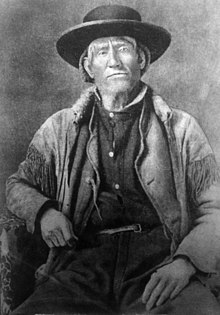
Back رجل الجبل Arabic Home de la muntanya Catalan Mountain Men German Mountain man Spanish مرد کوهستان Persian Mountain man French Մաունթինմեններ Armenian マウンテンマン Japanese 산사람 Korean Mountain men Dutch
 Jim Bridger, one of the most famous mountain men | |
| Occupation | |
|---|---|
Occupation type | Frontiersman (1800–1890) |
Activity sectors | Rocky Mountains, Sierra Nevada, Cascade Range, Great Plains, Great Lakes, Appalachian Mountains, Ozark Mountains, rivers |
| Description | |
| Competencies | Skinning, marksmanship, self-defense, hunting, fur trapping, trading, canoeing, horsemanship, tracking, exploring, mental and physical toughness, wilderness survival skills, medicine, frontier doctoring, diplomacy, English, French, Spanish, Russian, and Native American languages |
Related jobs | Longhunter, Coureur des bois, Surveyor, Woodsman, Fur trappers |
A mountain man is an explorer who lives in the wilderness and makes his living from hunting and trapping. Mountain men were most common in the North American Rocky Mountains from about 1810 through to the 1880s (with a peak population in the early 1840s). They were instrumental in opening up the various emigrant trails (widened into wagon roads) allowing Americans in the east to settle the new territories of the far west by organized wagon trains traveling over roads explored and in many cases, physically improved by the mountain men and the big fur companies, originally to serve the mule train-based inland fur trade.
Mountain men arose in a geographic and economic expansion that was driven by the lucrative earnings available in the North American fur trade, in the wake of the various 1806–1807 published accounts of the Lewis and Clark Expedition findings about the Rockies and the Oregon Country where they flourished economically for over three decades. By the time two new international treaties in early 1846 and early 1848[1] officially settled new western coastal territories in the United States and spurred a large upsurge in migration, the days of mountain men making a good living by fur trapping had largely ended. The fur industry was failing because of reduced demand and over trapping. With the rise of the silk trade and quick collapse of the North American beaver-based fur trade in the 1830s–1840s, many of the mountain men settled into jobs as Army scouts, wagon train guides or settled throughout the lands which they had helped open up. Others, like William Sublette, opened fort-trading posts along the Oregon Trail to serve the remnant fur trade and the settlers heading west.
- ^ see a) Oregon boundary dispute—Britain and the U.S. settled the ownership of the Pacific Northwest and the northern territories along current western Canada–US border, and
b) the 1848 treaty formally ending the Mexican–American War.
© MMXXIII Rich X Search. We shall prevail. All rights reserved. Rich X Search